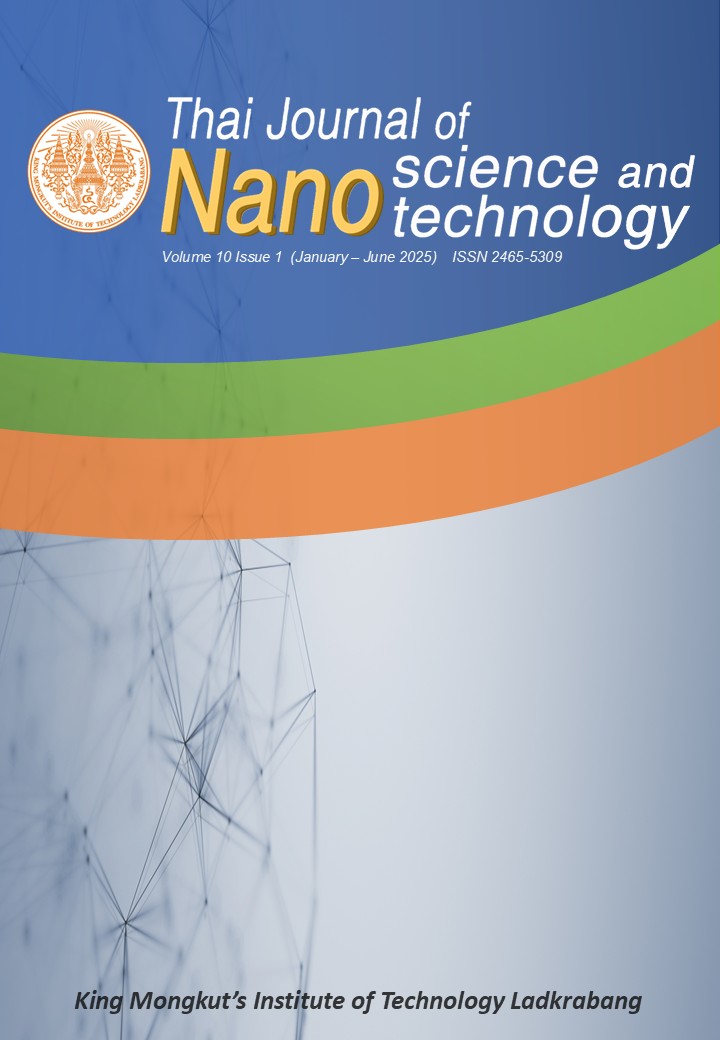Green Light Emission from Tb3+ ion doped Boro-Tellurite Glass Potential for Scintillation and Thermoluminescence Material Application
Main Article Content
Abstract
Rare-earth doped glasses have gained significant attention due to their potential applications in photonic devices, including scintillators and thermoluminescence dosimeters (TLD). Among these, terbium (Tb3+) ion is known for their strong green luminescence, making them valuable for optical and radiation detection technologies. The combination of TeO2 and other glass modifiers enhances the optical and structural properties of the host matrix, making it suitable for doping with rare-earth ions. The primary goal of this study is to synthesize and characterize a series of Tb3+ doped tellurite-based glasses with varying concentrations of terbium oxide (Tb2O3) for scintillation and thermoluminescence material application. Glasses with the molar composition (30-x) TeO2: 20B2O3: 20MgO: 10Li2O: 10Al2O3: 10La2O3: xTb2O3 (x is 0.0, 1.0, 2.0, 3.0, 4.0 and 5.0 mol%) were produced using a conventional melt-quenching approach. X-ray diffraction analysis confirmed that the glass was amorphous. In addition, the UV-VIS-NIR spectrometer recorded the absorption spectra of a number of peak values. As the concentrations of Tb3+ increase, both the radioluminescence (RL) and photoluminescence (PL) results increase. The glass samples exhibited strong luminescence spectra with prominent emission bands at 545 nm, corresponding to the characteristic transitions of Tb3+ ion. The highest luminescence efficiency of Tb3+ ion was observed at a concentration of 4 mol%. In the prepared glasses, the RL and PL obtained from different concentrations of Tb3+ ion is almost close to the green light region, as shown in the CIE 1931 chromaticity diagram. Furthermore, the thermoluminescence (TL) parameters were calculated using Chen is peak shape method, such as activation energy (E) and frequency factor (S). The developed glasses show promise for use in Scintillation and TLD.
Article Details

This work is licensed under a Creative Commons Attribution-NonCommercial-NoDerivatives 4.0 International License.
References
Mahmoud Hamdy Abaza, A. (2018). New Trend in Radiation Dosimeters. American Journal of Modern Physics, 7(1), 21-30. DOI: 10.11648/j.ajmp.20180701.13.
Sommat, V., Ornketphon, O., Kaewjaeng, S., Kothan, S., Limsuwan P., Thanyaphirak, W., Yasaka, P., Kirdsiri, K., Khondara, S., & Kaewkhao, J. (2004). A novel material for radiation detection application of zinc bismuth lithium borotellurite glass doped with Dy2 O3 Radiation Physics and Chemistry, 225, 112108. DOI: 10.1016/j.radphyschem.2024.112108.
West, W. G., & Kearfott, K. J. (2015). Optically Stimulated Luminescence Dosimetry: An Introduction. Solid State Phenomena, 238, 161-173. DOI: 10.4028/www.scientific.net/SSP.238. 161.
Kaewkhao, J., Wantana, N., Kaewjaeng, S., Kothan, S., & Kim, H. J. (2016). Luminescence characteristics of Dy3+ doped Gd O -CaO-SiO -B O scintillating glasses. Journal of Rare Earths, 34(6), 583-589. DOI: 10.1016/S1002-0721(16)60065-0.
Wantana, N., Kaewnuam, E., Damdee, B., Kaewjaeng, S., Kothan, S., Kim, H.J., & Kaewkhao, J. (2018). Energy transfer based emission analysis of Eu3+ doped Gd O -CaO-SiO -B O glasses for laser and X-rays detection material applications. Journal of Luminescence, 194, 75-81. DOI: 10.1016/j.jlumin.2017.10.004.
Laopaiboon, R., & Bootjomchai, C. (2015). Thermoluminescence studies on alkali-silicate glass doped with dysprosium oxide for use in radiation dosimetry measurement. Journal of Luminescence, 158, 275-280. DOI: 10.1016/j.jlumin.2014.10.017.
Boonin, K., Yasaka, P., Limkitjaroenporn P., Rajaramakrishna R., Askin A., Sayyed M.I., Kothan, S., & Kaewkhao J. (2020). Effect of BaO on lead free zinc barium tellurite glass for radiation shielding materials in nuclear application. Journal of Non-Crystalline Solids, 550, 120386. DOI: 10.1016/j.jnoncrysol.2020.120386.
Yasaka, P., Boonin, K., Duangjai, K., Kim, H. J., Kothan, S., & Kaewkhao, J. (2022). Luminescence, spectroscopic properties and reddish-orange emission from Eu3+ ion doped tellurite and fluorotellurite glasses: A comparative study. Optik, 265, 169531. DOI: 10.1016/j.ijleo.2022. 169531
Damdee, B., Kirdsiri, K., Kim, H.J., Yamanoi K., Wongdamnern, N., Kidkhunthod, P., Rajaramakrishna, R., & Kaewkhao, J. (2022). Physical and photoluminescence investigations of Eu3+ doped gadolinium borate scintillating glass. Radiation Physics and Chemistry, 200, 110386. DOI: 10.1016/j.radphyschem.2022.110386.
Xu, S., Fang, D., Zhang, Z., & Jiang Z. (2005). Effect of OH− on upconversion luminescence of Er3+-doped oxyhalide tellurite glasses. Journal of Solid State Chemistry, 178, 2159-2162. DOI: 10.1016/j.jssc.2005.03.023.
Rada, S., Culea, M., & Culea, E. (2008). Structure of TeO2 · B2O3 glasses inferred from infrared spectroscopy and DFT calculations. Journal of Non-Crystalline Solids, 354(52-54), 5491-5495. DOI: 10.1016/j.jnoncrysol.2008.09.009.
Halimah, M. K., Ami Hazlin, M. N., & Muhammad, F. D. (2018). Experimental and theoretical approach on the optical properties of zinc borotellurite glass doped with dysprosium oxide. Spectrochimica Acta Part A: Molecular and Biomolecular Spectroscopy, 195, 128-135. DOI: 10.1016/j.saa.2017.12.054.
Carnall, W. T., Fields, P. R., & Rajnak, K. (1968). Electronic Energy Levels of the Trivalent Lanthanide Aquo Ions. III. Tb3+. The Journal of Chemical Physics, 49(10), 4447–4449. DOI: 10. 1063/1.1669895.
Khrongchaiyaphum, F., Wantana, N., Kaewnuam, E., Pakawanit, P., Phoovasawat, C., Vittayakorn, N., Chanthima, N., Phongsa, A., Intachai, N., Kothan, S., Kim, H.J., & Kaewkhao, J. (2024). Novel Tb3+ doped borophosphate glass scintillator for X-ray imaging. Radiation Physics and Chemistry, 223, 111851. DOI: 10.1016/j.radphyschem.2024.111851.
Kesavulu, C. R., Kim, H. J., Lee, S. W., Kaewkhao, J., Kaewnuam, E., & Wantana, N. (2017). Luminescence properties and energy transfer from Gd3+ to Tb3+ ions in gadolinium calcium silicoborate glasses for green laser application. Journal of Alloys and Compounds, 704, 557-564. DOI: 10.1016/j.jallcom.2017.02.056.
Keskin, İ. Ç., & İlhan, M. (2023). Thermoluminescence Kinetic Parameters and Radioluminescence of RE3+ (RE = Pr, Sm, Tb, Ho, Er)-Doped Barium Tantalate Phosphors. Journal of Electronic Materials, 52(8), 5614-5630. DOI: 10.1007/s11664-023-10501-y.
Chen, R. (1969). Chen1969. Journal of The Electrochemical Society, 1254-1257.
İlhan, M., & Keskin, İ. Ç. (2020). Evaluation of structural behaviour, radioluminescence, Judd- Ofelt analysis and thermoluminescence kinetic parameters of Eu3+ doped TTB–type lead metaniobate phosphor. Physica B: Condensed Matter, 585, 412106. DOI: 10.1016/j.physb.2020.412106
İlhan, M., Keskin, İ. Ç., & Gültekin, S. (2020). Assessing of Photoluminescence and Thermoluminescence Properties of Dy3+ Doped White Light Emitter TTB-Lead Metatantalate Phosphor. Journal of Electronic Materials, 49(4), 2436-2449. DOI: 10.1007/s11664-020-07939-9.

